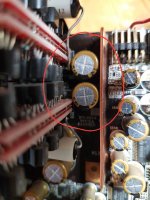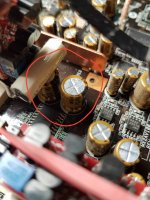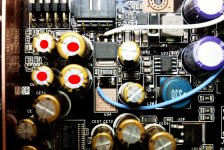Of course....thats obviously the first thing to look at! Thank you...Hi , check voltage regulators. Probably 15v where too much. I had the same issue , changed 7812 with a new one and the sound returned as before.
The 15v I have going to it externally however, isn't at the molex plug... That's still off the PC supply.
The 15V+- is at the two caps in the middle of the board.
So... Metering out my board, external power is coming into the board at the attachment points just fine. 2 pairs of filter caps next to the opamps, however, are missing one of the input voltages, either the +15 or -15. So the power going into the opamps is just 15v instead of 30v.
From here, I can't see where else to check... I also don't see any bulging caps or damaged components.

From here, I can't see where else to check... I also don't see any bulging caps or damaged components.


Well, is quite a time since I have been there (into the STX board)...
I think you should go step by step, measuring the +/- voltages from the connector to the point you find only one of these rails. I understood you are missing the -15, right?
If you can measure the current of these +/- lines, it could be useful to see if it may be a larger current on one than on other one. If so, then maybe a filtering cap it could leak too much, or so...
You see on the picture here the caps involved in filtering these two rails (before the opamps power inputs. Try to measure the surrounded components (there are two ferrite bead there also), and maybe you will find where the missing rail it actually disappear.
I think you should go step by step, measuring the +/- voltages from the connector to the point you find only one of these rails. I understood you are missing the -15, right?
If you can measure the current of these +/- lines, it could be useful to see if it may be a larger current on one than on other one. If so, then maybe a filtering cap it could leak too much, or so...
You see on the picture here the caps involved in filtering these two rails (before the opamps power inputs. Try to measure the surrounded components (there are two ferrite bead there also), and maybe you will find where the missing rail it actually disappear.
Attachments
Thank you for the reply! You may recall, my board is one of the highly modified ones. Those 2 larger caps are removed and that is where I attached my external PSU.Well, is quite a time since I have been there (into the STX board)...
I think you should go step by step, measuring the +/- voltages from the connector to the point you find only one of these rails. I understood you are missing the -15, right?
If you can measure the current of these +/- lines, it could be useful to see if it may be a larger current on one than on other one. If so, then maybe a filtering cap it could leak too much, or so...
You see on the picture here the caps involved in filtering these two rails (before the opamps power inputs. Try to measure the surrounded components (there are two ferrite bead there also), and maybe you will find where the missing rail it actually disappear.
Power is okay at the attachment points. I'll meter the remaining two caps and 2 beads and get back to you. Thanks for your help!
From running hot enough to reflow the solder?Sometimes a almost invisible solder "bridge" between adjacent pins provokes problem (short circuit). In this case, the regulator becomes hot. This occurred to me sometimes.
So, perhaps is interesting to measure for shorts.
At time I've repaired TV and sound systems (for almost 6 years long), this occurence is relatively common, due to various factors (eg. cheap PCB's in el-cheapo TV's). IC and SMD are the most offenders. Some metal residue (even some solder flakes), for some motive I don't know, don't reflow with solder...
Washing the board with hard short brush embedded in isopropyl alchool (or not too strong Thinner) solved most problems. Sometimes a fine blade is needed between some pins, or a careful resoldering playing with iron position between pins.
In fact, the washing become a routine in my PCB repair/making (at least the PCB ends with good appearece).
Washing the board with hard short brush embedded in isopropyl alchool (or not too strong Thinner) solved most problems. Sometimes a fine blade is needed between some pins, or a careful resoldering playing with iron position between pins.
In fact, the washing become a routine in my PCB repair/making (at least the PCB ends with good appearece).
Last edited:
Hello to everyone, I'm new in this forum.
Hello to everyone, I'm new in this forum.
Recently I bought the Asus STX II 7.1 card, looking for music to the best possible quality and although I was initially impressed by the time I thought I needed another level of quality, then I bought the "Op Apms Burson V6" and I replaced them with the "muses" and placed them in the socket I / V and in the buffer of the card and made a big change too.
I have not read anything here about "Op amps", but rather you dedicate to make electronic modifications and I know little of welding.
As you look for the highest possible quality on the card, I need a guide to follow to make modifications or guidance from a forum user.
Hello to everyone, I'm new in this forum.
Recently I bought the Asus STX II 7.1 card, looking for music to the best possible quality and although I was initially impressed by the time I thought I needed another level of quality, then I bought the "Op Apms Burson V6" and I replaced them with the "muses" and placed them in the socket I / V and in the buffer of the card and made a big change too.
I have not read anything here about "Op amps", but rather you dedicate to make electronic modifications and I know little of welding.
As you look for the highest possible quality on the card, I need a guide to follow to make modifications or guidance from a forum user.
Meh... I decided to go a different route, and turf the Xonar for a China DAC kit and use Toslink DSD instead.Sometimes a almost invisible solder "bridge" between adjacent pins provokes problem (short circuit). In this case, the regulator becomes hot. This occurred to me sometimes.
So, perhaps is interesting to measure for shorts.
But of course, retain my Burson opamps and regulators and discrete clock!
The 10 ohm resistors it should be there as it are. Their impact over the signal quality or level is minimal. These resistors it compensate (lower) the capacity of the connected output cables, seen by the output stage (buffer).
1 ohm it will be a too low value. A higher capacity seen by the output stage (circuit), it can destabilise its parameters or functionality...
1 ohm it will be a too low value. A higher capacity seen by the output stage (circuit), it can destabilise its parameters or functionality...
IMHO adding external power supply to the molex won't make much an improvement. There's switching regs ICs on the board that provide +/- 12V for the IV and headphone amps from +5V on the molex and they're noisy. Also the 5V analog for the DAC is powered from +12V of the molex through a 7805 - here you will get SOME improvement. 3.3V comes directly from the PCIex slot and it's... dirty.
The best results would be to add linear regulated power on the board with separate feeds to +12,-12, 5 and 3.3V.
If you really feel the need to add external power to the molex I'd say 2.5/3A for the 5V line and 0.5/1A for the 12V line.
I've connected the molex many times AFTER the rest of the PC was on and I think you will have no problems powering the molex first as long as the external supply is grounded to the PC supply (even at the molex connector).
In short you will make no smoke around if the supplies share the same ground.
I add external power to the STX II 7.1 molex with 5A for 5V and 1.8A for 12V. It ok for 2ch but with 7.1 It seems not enough power. Do you have any recommend about current of 5V and 12V when use for 7.1? Thanks.
IMHO adding external power supply to the molex won't make much an improvement. There's switching regs ICs on the board that provide +/- 12V for the IV and headphone amps from +5V on the molex and they're noisy. Also the 5V analog for the DAC is powered from +12V of the molex through a 7805 - here you will get SOME improvement. 3.3V comes directly from the PCIex slot and it's... dirty.
The best results would be to add linear regulated power on the board with separate feeds to +12,-12, 5 and 3.3V.
If you really feel the need to add external power to the molex I'd say 2.5/3A for the 5V line and 0.5/1A for the 12V line.
I've connected the molex many times AFTER the rest of the PC was on and I think you will have no problems powering the molex first as long as the external supply is grounded to the PC supply (even at the molex connector).
In short you will make no smoke around if the supplies share the same ground.
I add external power to the STX II 7.1 molex with 5V 5A and 12V 1.8A. It's good for 2ch but seems not enough power for 7.1ch. Do you have any advice?
Hey guys. Does any know how to mod the cable of the STX II 7.1 model (or buy one modded) so that it is not that ugly and does not need to twist in order to connect. I am looking to get it as more presentable as possible for a one slot space (the slot next to the main unit).
Dear friends,
I digged out my old Xonar HDAV 1.3 (the big one) to make it a gift for my brother (I'm a little on budget on this).
The card:
Bild: 20181105_110245mlerd.jpg - abload.de
Can you please advise me on a few things, if that the procedure would be correct:
1. I would like to ad external power to the +12 and -12 connectors of the pcb. Now there are two voltage regulators on board.
Plan: Remove the output pins of the voltage regulators and connect external +/-12v.
Voltage regulators:
Bild: 20181105_105940ofe5u.jpg - abload.de
2. The clock with external power. Plan: desolder the old one and connect the masterclock output where the old clock was.
Questions: Which is the masterclock input?
The tcxo:
Bild: 20181105_104409cli1y.jpg - abload.de
3. Replace the 22n and 8n foil caps with Wima caps around the Opamps. I read that the cap-values are not ideal. Which ones are ideal?
Bild: 20181105_110132wtcqd.jpg - abload.de
4. 3,3v external voltage supply: I'm not sure about that one since there is no big voltage regulator to tap into.
How do I cut the internal pcie 3.3V supply and where to connect the external +/-3.3v?
I'm thinking about buying one of those Audio-GD class a PSUs.
I digged out my old Xonar HDAV 1.3 (the big one) to make it a gift for my brother (I'm a little on budget on this).
The card:
Bild: 20181105_110245mlerd.jpg - abload.de
Can you please advise me on a few things, if that the procedure would be correct:
1. I would like to ad external power to the +12 and -12 connectors of the pcb. Now there are two voltage regulators on board.
Plan: Remove the output pins of the voltage regulators and connect external +/-12v.
Voltage regulators:
Bild: 20181105_105940ofe5u.jpg - abload.de
2. The clock with external power. Plan: desolder the old one and connect the masterclock output where the old clock was.
Questions: Which is the masterclock input?
The tcxo:
Bild: 20181105_104409cli1y.jpg - abload.de
3. Replace the 22n and 8n foil caps with Wima caps around the Opamps. I read that the cap-values are not ideal. Which ones are ideal?
Bild: 20181105_110132wtcqd.jpg - abload.de
4. 3,3v external voltage supply: I'm not sure about that one since there is no big voltage regulator to tap into.
How do I cut the internal pcie 3.3V supply and where to connect the external +/-3.3v?
I'm thinking about buying one of those Audio-GD class a PSUs.
- Home
- Source & Line
- PC Based
- Xonar ST/STX mods...
